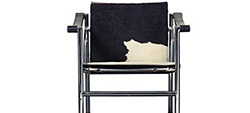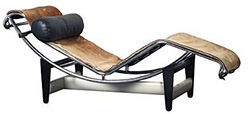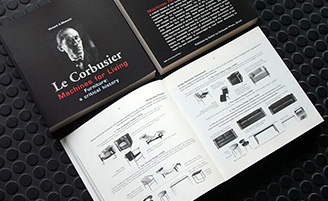Le Corbusier's prototypes were adapted by Heidi Weber for industrial, serial production.

LC 101
Hight 63 cm, Width 99,5 cm, Depthe 68 cm, “Fauteuil grand confort”, big size. Steel tube frame, nickel or chrome plated, or black. Spiral spring mesh. Loose cushions made to measure;
horse-hair with down, covered with leather or fabric.

LC 102
Hight 68 cm, Width 76 cm, Depthe 70 cm, “Fauteuil grand confort”, small size. Steel tube frame, nickel or chrome plated, or black.Spiral spring mesh. Loose cushions made to measure;
horse-hair with down, covered with leather or fabric.

LC 103
Hight 65 cm, Width 60 cm, Depthe 65 cm. "Fauteuil Dos Basculant" with
mobile back.
Steel tube frame, nickel or chrome plated.
Foal skin or fabic cover.
Arm rest leather strips.

LC 104
Witdth 56,5 cm, Length 161 cm,
"Chaise-longue". Easy chair with notchless adjustment.
Lower frame of black-and-white iron. Upper frame of nickel or chrome plated steel tube. Foal skin or fabric covered spanning. Neck roll.
A global success story

Presentation in 1929, Salon d’Automne

Presentation in 1958 in Heidi Weber's Mezzanin
"Charlotte was commissioned with the management of our furniture models together with Thonet from 1929. This project could have been brilliant, but it ended up being trashy. (Le Corbusier)
Turning Point
From their first meeting in Paris, Heidi Weber’s creative infatuation also revived Le Corbusier’s enthusiasm. The partners decided to extend their collaboration to include the manufacturing of certain pieces of furniture. Until this point, his prototypes had never found a buyer, as Le Corbusier had abandoned this activity in 1929 when his appeals to the manufacturing industry to mass produce his furniture fell on deaf ears.
Back in Zurich, Heidi Weber immediately began to look for premises where the furniture could be produced; luckily, she found a suitable place in the Spiegelgasse which was quite close to her own studio. These premises served as the factory for the four seat and armchair models and production began at the end of October, 1958.
Le Corbusier was impressed by Heidi Weber’s enthusiasm for his furniture and by her dynamism. Within three months of receiving the blueprints, she was able to invite him to view the first serial models. Rather than rough prototypes, she was able to show him the first production run of twenty-five of each of the four models which had all been produced in her little workshop. Le Corbusier was surprised and excited, his only recommended correction was a hardly noticeable shortening of the front armsupports of the “Dos Basculant”.
Le Corbusier signed the first contract for the production rights with Heidi Weber on December 1st, 1959. This was after he had written to her a few months previously: “I will sign a contract with you, but, first of all, I want a proof of your capability.” With this first contract he granted her the rights for Europe and the USA for three years. On January 1st, 1963, the same contract was ratified, extending the period to fifteen years to 1978. This time including the rights for South America.
The Production run smoothly and sales were extremely successful – orders were coming in from New York, Hong Kong and from other parts of the world – so much so that Heidi Weber was forced to make an important decision. Her small workshop was working to full capacity and she would not really be able to meet the steady increase of worldwide demand. At this point, she was forced to choose whether she wanted to stay in the furniture business or whether she would prefer to outsource her production and sublicense it to a well established furniture production company.

Patent certificate for Heidi Weber

The only authorized furniture collection by Le Corbusier
Global market acceptance
Heidi Weber granted sublicenses
Cassina S.p.A. a family business in the town of Meda near Milan was one of the many potential licensees. Run by Franco Cassina, this company had been focusing on a limited sector of the furniture market. They specialised in producing wooden interiors for ships and hotels. To break out of this closed market, they needed a new line of furniture and a consumer brand. Heidi Weber convinced their directors that by manufacturing Le Corbusier’s furniture they would make an important strategic move to capture the attention of an entirely new consumer group. After long negotiations, Heidi Weber signed a sublicense contract with Cassina S.p.A. on October 23th, 1964 which granted them the production and distribution rights for Italy. This license was extended to include Europe in July 1965 and, one year later, Heidi Weber extended this sublicense again to include the USA.
Le Corbusier had no interest in meeting the sublicense, and left the decision process entirely to Heidi Weber. As far as he was concerned, they worked for Heidi Weber. With typical conscientiousness, she made it her task to implement strict quality controls whilst offering Cassina her support and the benefits of her considerable experience. It is regrettable that after the death of Le Corbusier on August 25th, 1965 and when her original contract with him ran out in 1978, Heidi Weber was no longer able to exert any influence over the production. Unfortunately the contributions of Heidi Weber were not properly valued nor was the original contract between the two not taken over after 1978 by the Le Corbusier Foundation in Paris, his estate administrators. It is also important to note that Heidi Weber always respected the conditions and the spirit of the contract with Le Corbusier in 1959 and 1962, namely to only produce four models, by his own inventions. During the fifteen years of her contract with Le Corbusier, she never produced any other models and for sure she would have never accepted to produce any new models based on some sketches apparently found after his death at the Le Corbusier Foundation in Paris.
Heidi Weber’s achievements are manifold. One of the most important ones was convincing Le Corbusier that his furniture was not old fashioned, but in fact the most contemporary and modern furniture of the twentieth century. Her greatest contribution to the serial production was the quality manufacturing and her aesthetic alternations to the models which completed the collection. This played a decisive role in the ongoing worldwide success of the Le Corbusier furniture collection whitch continues until today.

Vincent Masucci: Le Corbusier – Machines for Living – Furniture: a critical history
About the authorship
In a critical historical debate and with a particular and profund focus on the authorship of documentary, the author describes in 388 pages the different levels and phases of development of the world-famous furniture of Le Corbusier, that Heidi Weber has brought to productivity and which she first presented to the public in 1959.
